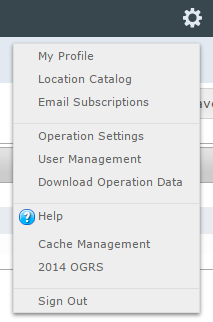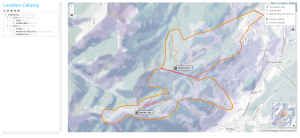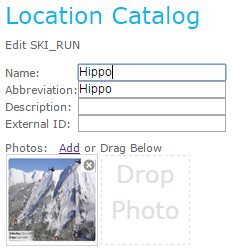Difference between revisions of "Editing locations in the location catalog"
(→Step-by-step description) |
|||
| (18 intermediate revisions by one other user not shown) | |||
| Line 5: | Line 5: | ||
==Background== | ==Background== | ||
| − | The ability to edit locations and delete obsolete | + | The ability to edit locations and delete obsolete locations should allow operations to maintain a clean catalog of relevant locations at all times. However, please note that editing locations affects all observations that have ever been associated with the given location. For example, if you change the location of a weather site, all associated historic observations will be moved to the new location. Similarly, when you change the name of a ski run, all of the associated historic avalanche observations will then be associated with the new name of the ski run. |
We recommend the following '''guidelines for the maintenance of your location catalog''': | We recommend the following '''guidelines for the maintenance of your location catalog''': | ||
| − | * Editing is appropriate for minor changes in the attributes (e.g., fixing of typos, name changes, minor adjustments of their geometries) of | + | * Editing is appropriate for minor changes in the attributes (e.g., fixing of typos, name changes, minor adjustments of their geometries) of locations that still represent the same piece of terrain. This approach will ensure that the time series (e.g., long-time observations at a weather site with a changing name) will be maintained. |
| − | * If the geometry of a location changes | + | * If the geometry of a location changes considerably, it would be better to delete the location and create a new location under the same name. This approach will ensure that all observations associated with this location are displayed at their appropriate locations. |
==Step-by-step description== | ==Step-by-step description== | ||
| Line 18: | Line 18: | ||
|- | |- | ||
|class="StepNum" | 1. | |class="StepNum" | 1. | ||
| − | |[[File:AdminMenuOperationAdministrator.png|300px|thumb|right|Fig. 1: Administration menu for operation administrator]] Select | + | |[[File:AdminMenuOperationAdministrator.png|300px|thumb|right|Fig. 1: Administration menu for operation administrator]] Select 'Location Catalog' from the administration menu (cog wheel) (Fig. 1). |
|- | |- | ||
|class="StepNum" | 2. | |class="StepNum" | 2. | ||
| − | |[[File:LocationCataolgScreen.png|300px|thumb|right|Fig. 2: Location catalog screen]] | + | |[[File:LocationCataolgScreen.png|300px|thumb|right|Fig. 2: Location catalog screen]] The location catalog screen (Fig. 2) shows your location hierarchy tree and a map. |
| − | + | {{Note|Please note that depending on your connectivity and the size of your location catalog, it might take a while to load your entire location catalog. A message will indicate the location catalogue is downloading.|NoteWithImage}} | |
|- | |- | ||
|class="StepNum" | 3. | |class="StepNum" | 3. | ||
| − | |Expand the location hierarchy tree | + | |Expand the location hierarchy tree as required by clicking on the little plus (+) signs left of locations that contain other locations and click to navigate to the location you would like to edit. The locations are sorted by location type first and alphabetic location name second. |
| − | + | Alternatively you can search your location catalog by clicking on the [[File:ButtonSearch.png]] button at the top of the location tree. | |
|- | |- | ||
|class="StepNum" | 4. | |class="StepNum" | 4. | ||
| − | |[[File: | + | |[[File:LocationEditMode.png|300px|thumb|right|Fig. 3: Location map in editing mode]] Right click on the the location you want to edit. This will open a small menu with an edit option. To have access to this menu item, you need to be either an operation administrator or a super user. Select the edit option. This will replace the location tree with a location form filled with the information of the location to be edited and the map section will change from viewing to editing mode (Fig. 3). |
| − | {{ | + | {{Note|Depending on the complexity of your location (i.e., number of points), it might take a while to load your location in editing mode. You might even get an error message from Google Chrome informing you that the application is taking too long to respond. Click on 'Wait for application' to continue.|NoteWithImage}} |
| + | |||
|- | |- | ||
|class="StepNum" | 5. | |class="StepNum" | 5. | ||
|Edit any of the information in the fields at the top of the pop-up window: | |Edit any of the information in the fields at the top of the pop-up window: | ||
| − | * '''Name''' (required): Full name of the location | + | * '''Name''' (required):<br/>Full name of the location |
| − | * '''Abbreviation''' (required): Abbreviation to be used for the location in the tabular InfoEx reports. | + | * '''Abbreviation''' (required):<br/>Abbreviation to be used for the location in the tabular InfoEx reports. |
| − | * Description: Detailed description of the location | + | * '''Description''' (optional):<br>Detailed description of the location |
| − | * External ID: The external ID of a location is required if your operation submits their observations from an external database system via the API (see [[ | + | * '''External ID''' (only accessible to super users):<br/>The external ID of a location is required if your operation submits their observations from an external database system via the API (see [[Submitting observations to the InfoEx via the CAAML 3.0.3 API]] for more information). The external ID is also required for locations that already existed in the legacy CAAML driven InfoEx and have historic observation associated with them. |
| − | * Elevation (weather site only): Elevation of weather site in meters. | + | * '''Elevation''' (weather site only):<br/>Elevation of weather site in meters. When you create a new weather site, its elevation will automatically be extracted from the digital elevation model (DEM) of the map. You can, however, overwrite the automatically created value. |
{{Note|Since locations are primarily referred to by name in the InfoEx system, it is not advisable to create multiple location of the same type with the same name. However, the system currently does not explicitly check for it.|NoteNoImage}} | {{Note|Since locations are primarily referred to by name in the InfoEx system, it is not advisable to create multiple location of the same type with the same name. However, the system currently does not explicitly check for it.|NoteNoImage}} | ||
|- | |- | ||
|class="StepNum" | 6. | |class="StepNum" | 6. | ||
| − | |If necessary, modify the geometry of the location. | + | |If necessary, modify the geometry of the location. |
| − | * | + | |
| − | * | + | * ''Editing the geometry directly using the available drawing tools''.<br/>See [[Editing the geometry of an existing location using the available drawing tools]] for more details on this method. |
| − | + | ** ''Replacing the geometry by uploading a new geometry from a Google Earth KML file''.<br/>See [[Importing the geometry of a location from a KML file]] for more details on this method. | |
| + | |||
|- | |- | ||
|class="StepNum" | 7. | |class="StepNum" | 7. | ||
| − | | | + | |[[File:CatalogAddPhotoToLocation.png|300px|thumb|right|Fig. 5: Adding a photo to a location.]] |
| − | {{ | + | To add a photo to a location, drag the photo onto the square below the regular information fields for the location or click on the 'Add' hyperlink above the square to open the regular file dialog box. You can add as many photos as you like. |
| − | {{ | + | {{Note|The InfoEx system will perform more quickly for you if you limit the size of these images to a less than 1 MB.|NoteWithImage}} |
| + | * To change the order of the uploaded images, arrange the thumb nails into the desired order. | ||
| + | * To delete a photo, click on the [[File:ButtonDelete.png]] in the top right corner of the photo. | ||
| + | |- | ||
| + | |class="StepNum" | 8. | ||
| + | |Click on {{ButtonGrey|Update}} to save the changes. This will submit the changes to the InfoEx database and change the mode of the location catalog back to viewing. | ||
|} | |} | ||
==Related documents== | ==Related documents== | ||
| − | + | {{PagesLocations}} | |
| − | |||
| − | |||
| − | |||
| − | |||
| − | |||
==Functionality tested by== | ==Functionality tested by== | ||
| − | * | + | * Dec. 22, 2013: Pascal Haegeli |
| − | [[Category:Super User]][[Category:Operation Administrator]][[Category:Locations]][[Category:Software Issues]][[Category:Version | + | [[Category:Super User]][[Category:Operation Administrator]][[Category:Locations]][[Category:Software Issues]][[Category:Version 3.4.0]] |
Latest revision as of 17:11, 2 December 2015
| REQUIREMENTS | |
| Permission | Operation Administrator or higher |
| Connectivity | Online only |
This document describes how to edit locations in the location catalog of your operation.
Background
The ability to edit locations and delete obsolete locations should allow operations to maintain a clean catalog of relevant locations at all times. However, please note that editing locations affects all observations that have ever been associated with the given location. For example, if you change the location of a weather site, all associated historic observations will be moved to the new location. Similarly, when you change the name of a ski run, all of the associated historic avalanche observations will then be associated with the new name of the ski run.
We recommend the following guidelines for the maintenance of your location catalog:
- Editing is appropriate for minor changes in the attributes (e.g., fixing of typos, name changes, minor adjustments of their geometries) of locations that still represent the same piece of terrain. This approach will ensure that the time series (e.g., long-time observations at a weather site with a changing name) will be maintained.
- If the geometry of a location changes considerably, it would be better to delete the location and create a new location under the same name. This approach will ensure that all observations associated with this location are displayed at their appropriate locations.
Step-by-step description
| 1. | Select 'Location Catalog' from the administration menu (cog wheel) (Fig. 1). | ||
| 2. | The location catalog screen (Fig. 2) shows your location hierarchy tree and a map.
| ||
| 3. | Expand the location hierarchy tree as required by clicking on the little plus (+) signs left of locations that contain other locations and click to navigate to the location you would like to edit. The locations are sorted by location type first and alphabetic location name second.
Alternatively you can search your location catalog by clicking on the | ||
| 4. | Right click on the the location you want to edit. This will open a small menu with an edit option. To have access to this menu item, you need to be either an operation administrator or a super user. Select the edit option. This will replace the location tree with a location form filled with the information of the location to be edited and the map section will change from viewing to editing mode (Fig. 3).
| ||
| 5. | Edit any of the information in the fields at the top of the pop-up window:
| ||
| 6. | If necessary, modify the geometry of the location.
| ||
| 7. |
To add a photo to a location, drag the photo onto the square below the regular information fields for the location or click on the 'Add' hyperlink above the square to open the regular file dialog box. You can add as many photos as you like.
| ||
| 8. | Click on Update to save the changes. This will submit the changes to the InfoEx database and change the mode of the location catalog back to viewing. |
Related documents
- Location catalog overview
- Location types and symbology
- Location hierarchy
- Adding locations to the location catalog
- Editing locations in the location catalog
- Deleting locations from the location catalog
- Changing the hierarchy among your locations
- Searching for a location in the location catalog
- Viewing photos
- Downloading your location catalog as a KML file
Functionality tested by
- Dec. 22, 2013: Pascal Haegeli



